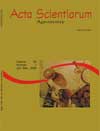<b>Avaliação de procedimentos de acidificação de conservas de palmito foliar de pupunha (<em>Bactris gasipaes</em>)</b> - DOI: 10.4025/actasciagron.v27i2.1842
Resumo
No processamento de conservas de palmito (Bactris gasipaes), a acidificação deve ser aplicada com eficiência, principalmente, para prevenir o desenvolvimento da bactéria Clostridium botulinum. Considerando este importante preceito, a pesquisa avaliou a eficiência de três procedimentos de acidificação no processamento, os quais foram estimados em pH 4,3, 4,2 e 3,9, para abaixar o pH do palmito fresco até o pH de equilíbrio nas conservas, que deve ser igual ou abaixo de 4,5. Apenas a acidificação que teve o pH 4,3 por estimativa produziu, em algumas conservas, valores de pH superiores, à 4,5. A conserva processada com salmoura de 4% foi a preferida, seguida pela de 3%. Foi marcante o paladar adocicado, característico do palmito fresco, apenas nas conservas contendo salmoura de 2%. Dentre os tratamentos testados, apenas o que teve por estimado o pH 3,9 pode ser recomendado, com segurança, para uso na agroindústria de conservas de palmito foliar (tolete) de pupunha. Ainda assim, deve ser considerada prática obrigatória a execução do procedimento de acidificação para cada lote do processamento, pois, como demonstrado nessa pesquisa bem como em outras prévias, é comum a variação de pH no palmito in natura. Essas recomendações, quando aplicadas com eficiência, resultarão em segurança alimentar efetiva para a sua agroindustrialização, independentemente da salmoura escolhida para a conserva.Downloads
DECLARAÇÃO DE ORIGINALIDADE E DIREITOS AUTORAIS
Declaro que o presente artigo é original, não tendo sido submetido à publicação em qualquer outro periódico nacional ou internacional, quer seja em parte ou em sua totalidade.
Os direitos autorais pertencem exclusivamente aos autores. Os direitos de licenciamento utilizados pelo periódico é a licença Creative Commons Attribution 4.0 (CC BY 4.0): são permitidos o compartilhamento (cópia e distribuição do material em qualqer meio ou formato) e adaptação (remix, transformação e criação de material a partir do conteúdo assim licenciado para quaisquer fins, inclusive comerciais.
Recomenda-se a leitura desse link para maiores informações sobre o tema: fornecimento de créditos e referências de forma correta, entre outros detalhes cruciais para uso adequado do material licenciado.




















































